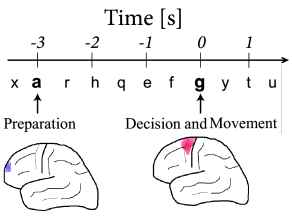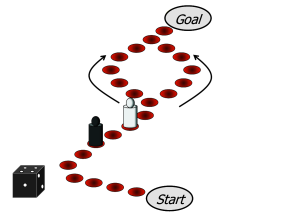16.5 Human Decisions, Determinism, and Free Will
In the previous section, we have compared the process of decision making to a ball in an energy landscape. However, as outlined in the introduction of this chapter, decision making incorporates a broad set of phenomena and processes (418; 455). Here we sketch a link of the simplified model of decision making to the bigger picture.
Adult humans in a state of normal health feel that they are in control of their actions: ’The street is too busy, therefore I decide to take the safer underground pathway’; – ’Because there have been many accidents at this crossing, I decide to break early and be particularly careful’; – ’I will rather prepare for the exams, than go to the movies’. We all know examples of consciously controlling our decisions and actions.
Voluntary control of actions can be understood in opposition to pure reflexes (203). If the doctor hits the right spot on your knee, your foot moves without you intending it. If an object approaches your eyes from the front, you automatically move your head. There are also cases where reflexes have been learned from experience. For example, during your first driving lessons you had to consciously control your foot in order to step on the brakes when a red traffic light appeared in front of your car. After years of experience, you start to break even before you become aware of a conscious decision. Similarly, if you are a good tennis player you will respond to a serve with an arm movement that was trained so often that it has become as fast as a reflex. Nevertheless, you could decide to take back control and try to inhibit your automatic response, if for some reason you want to disturb your opponent. The feeling of voluntary control is what makes you feel responsible for the things you do.
| A | B |
|---|---|

|
 |
The movement of our arms and legs is controlled by muscles which in turn receive action potentials from the brain via the spinal cord. The human cortex contains several areas that are involved in voluntary actions. The question of where and how the brain controls our decisions and represents our will has triggered the research field of ’neuroscience of volition’ (203).
16.5.1 The Libet experiment
The classic experiment in the research field of human volition was performed by Libet (297). In this experiment, subjects decide on their own when to move their right hand. After each trial subjects report when they felt the ‘urge to move’, with respect to a rapidly rotating hand of a clock. The reported ‘urge to move’ is in fact about 200ms earlier than the actual movement. Most interestingly, however, electrical brain activity measured by EEG recordings indicates that the brain exhibits signals of preparatory activity already several hundred milliseconds before the reported ‘urge to move’. Thus, if we accept to interpret the felt ‘urge to move’ as the conscious decision to move the hand, then we must also accept the fact that the brain has unconsciously prepared our decision.
A modern and debated variant of the Libet experiment is shown in Fig. 16.11A. The main difference to the original Libet experiment (where the decision was limited to ‘move’ or ‘not move’) is that subjects now hold two buttons, one in the left and the other in the right hand (490). Subjects are free to decide when to move and press either of the two buttons. While subjects perform the experiment, they watch a stream of letters at a rate of two letters per second. At the end of each trial, they indicate at which letter they had felt the ‘urge to move’. The reported letter serves as a timing reference for the subsequent analysis.
During the experiment, brain activity was recorded through functional magnetic resonance imaging (fMRI). Using statistical pattern classification techniques, the authors aimed at predicting the final response outcome (left or right) based on the activity patterns in localized brain areas. If brain activity contained no cue about the final decision, the prediction would be always 50 percent. However, the authors found that activity patterns in fronto-polar cortex 5 seconds before the reported ‘urge to move’ allowed them to predict the final choice (left or right) with a precision of 55 - 60 percent (490) which is above chance but far from a reliable prediction.
16.5.2 Relevant and irrelevant decisions - a critique
What, if anything, can we learn about decision making and volition from these and similar experiments? In a naive interpretation, the results seem to suggests that the brain has taken its own decision a long time before the subject becomes aware of it. As Wolfgang Prinz puts it: ’We don’t do what we want, but we want what we do’ (408).
There is little doubt that our actions, plans, and wishes are represented in the brain. Our childhood memories are stored in our brain; our knowledge of the world is memorized in the brain; our values and priorities acquired through education, reading, understanding, trial and error, or simply through being embedded in our culture, must also be stored in the brain. Thus, a large fraction, if not all, of what we consider our conscious personality is located in the brain.
Most actions where we care about our decision are relevant choices. The decision of whether to take the risky shortcut across a busy street or the safer underground pathway depends on what we have experienced in the past. Similarly, the decision in the board game of Fig. 16.1A depends on the players attitude toward risk which has been formed by previous experiences in similar situations. However, the decision task in the scientific experiment of Libet (297) or Soon et al. (490) is a completely irrelevant one. Subjects don’t really care, whether they move the left or right finger. The decision has nothing to do with life-long experience or attitude toward risk. In cases like this one, any decision is arbitrary and therefore easily influenced by noise. Think of the board game of Fig. 16.1A and compare it with the situation in Fig. 16.11B. While the first one asks for a decision between a risky and a safe path, the second one poses an irrelevant choice. In the latter case, we might just for the sake of advancing the game, decide to go left, based on the whim of the moment, but we know that right would do just as well.
Interestingly, even in the irrelevant situation of the experiment of Soon et al. (490), the predictive power of the brain activity five seconds before the conscious ‘urge to move’ is only in the range of 60 percent. Moreover, in a different experimental design subject could ‘veto’ at the last moment a previously prepared movement suggesting the possibility of voluntary inhibition of actions that are only weakly predicted (64). Finally, there is also the problem whether we can really identify a reported ‘urge to move’ with a precise moment of decision. If we take the picture of the ball in the energy landscape, the ball starts to roll in certain direction while still remaining in the flat region. But this does not yet imply a final decision, because novel input could tilt the energy landscape in the opposite direction.